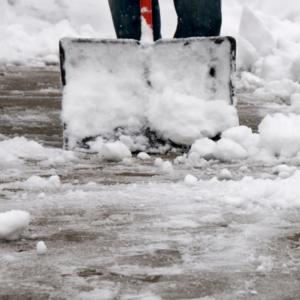Follow these tips to protect yourself from slips and falls in the cold-weather months
There are many hazards associated with winter weather that can pose an increased risk for mild traumatic brain injury, or concussion. Everyday activities like driving the kids to school and shopping for groceries can become more dangerous when ice and snow are involved. Take extra precaution this winter to lower your risk for concussion with these 10 tips.
1. Wear appropriate shoes.
Purchase non-slip shoes with traction to avoid slipping on the ice or snow. The Military Health System recommends shoes with rubber soles that have treads or a raised pattern on the bottom.
2. Be careful when entering and exiting your vehicle
The University of Pittsburgh Medical Center (UPMC) suggests leaning on your vehicle and using it as support if you need to.
3. Keep an ice scraper in your vehicle.
Maintaining a clean, clear windshield will make driving conditions as safe as possible. Use a wintertime formula for your windshield washer fluid and replace tires with all-weather or snow versions if necessary.
4. Clear your sidewalks and driveway.
Work slowly when doing outdoor chores like shoveling to avoid slipping and falling. If you live somewhere where ice and snow are common, purchase rock salt to have on hand before a snowstorm approaches. The CDC notes that sand and cat litter can also be used for de-icing.
5. Don’t carry too much when running errands.
UPMC advises people to avoid carrying too much or walking with their hands in their pockets during icy or snowy conditions. Doing either of these things could make it difficult to regain your footing if you slip.
6. Make sure your clothes fit properly.
This is especially important if you’re participating in any winter activities like ice skating or skiing, as loose or baggy clothing can pose a fall risk.
7. Walk like a penguin.
The CDC notes that many cold-weather injuries happen due to sidewalks, steps, driveways and porches that are covered in ice. One way to avoid slipping is to walk like a penguin. This means maintaining your balance and center of gravity by walking with your feet and arms spread wide in a “waddle” fashion. Point your feet outward, spread your legs, walk flat-footed, take short steps and use your arms for balance.
8. Watch for black ice.
If ice appears wet on the surface, it might be black ice. Be mindful of this when driving, as black ice can make road conditions more dangerous.
Know the signs and symptoms of concussion. Because slips and falls occur so commonly in the wintertime, it’s important to know when a fall may have led to concussion. Symptoms of concussion vary, but some early signs include headache or a feeling of pressure in the head, temporary loss of consciousness, confusion, dizziness, nausea, vomiting, slurred speech and fatigue, according to the Mayo Clinic.
Keep these tips in mind during the winter season to prevent concussion in yourself and those around you.

